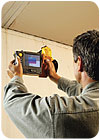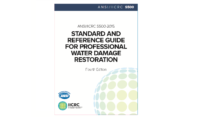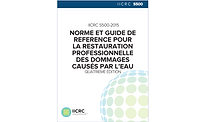Whether you are a restorer, adjuster, property owner or manager, the guidance provided in the 3rd Edition of the Institute of Inspection, Cleaning and Restoration Certification S500 Standard and Reference Guide for Professional Water Damage Restoration will assist you in making appropriate decisions when it comes to restoring wet buildings and contents.
The S500, for the first time, includes some guidance in determining the appropriate amount of drying equipment initially needed on water-damage restoration projects when employing dehumidification in the process. (It should be noted that there are other methods of drying buildings and their contents, such as hot air drying systems and other forms of ventilation, including an open drying system; however, the following only applies directly to dehumidification methods.)

To begin extracting a formula from the Standard, we must first define “class of water.” Not to be confused with “category of water,” which have to do with whether the water is contaminated or not (e.g., Category 1 water originates from a clean water source; Category 2 water has some level of contamination and 3 is contaminated.) The term “class of water” is not new; the IICRC-approved Applied Structural Drying (ASD) courses have been describing four classes of water for some time. However, the term is new to the S500. It is the “initial amount of water and the likely or anticipated rate of evaporation based upon the quantity and type of wet materials in the affected space.” The four classes of water are:
Related Reading
- Class 1 (least amount of water, absorption and evaporation): Water losses that affect only part of a room or area, or larger areas containing materials that have absorbed minimal moisture. Little or no wet carpet and/or cushion is present.
- Class 2 (large amount of water, absorption and evaporation): Water losses that affect at least an entire room of carpet and cushion (pad). Water has wicked up walls less than 24 inches. There is moisture remaining in structural materials (e.g., plywood, particle board, structural wood, VCT, concrete. substructure soil).
- Class 3 (greatest amount of water, absorption and evaporation): Water may have come from overhead. Ceilings, walls, insulation, carpet, cushion and subfloor in virtually the entire area are saturated.
- Class 4 (Specialty drying situations): These consist of wet materials with very low permeance/porosity (e.g., hardwood, plaster, brick, concrete, light weight concrete and stone). These types of losses may require longer drying times and special methods.
The next step is to perform an inspection and develop a preliminary determination as to the category of water. Let’s assume for the purpose of this discussion that the preliminary determination is that the category of water is “1.” As part of the inspection we would also want to establish our drying goal. In the S500, a distinction is made between a “dry standard” and a “drying goal.” The dry standard is determined by taking moisture content (MC) readings from known dry materials in an undamaged area of structure (sometimes referred to as normal EMC). From the dry standard you can then establish your drying goal. The drying goal is a target moisture level that may be the same as the dry standard or within an acceptable proximity of the dry standard. For example, at Section 12.4.1.5 it states: “…then properly dry exposed wood framing to within four percentage points of normal EMC. At a minimum, wood framing materials should be below 16% MC before installing new drywall.”
In order for drying to take place expeditiously, “It is recommended that consideration be given to whether demolishing or removing structural materials is appropriate in setting up the initial drying system.…Unrestorable structural components should be removed. In some cases the materials may not be damaged but their presence can slow down the drying process. (e.g., wallpaper over wet drywall, cabinets that cover wet drywall, carpet and pad over wood flooring).”
Now that the excess water has been extracted, the un-restorable materials removed and the impediments to drying addressed, it is time to start setting up the equipment. We have already determined that the damage is from Category 1 water and that we are going to use a closed drying system (i.e., not using outside air) and dehumidification. The most common class of water damage is Class 2. So therefore we will use that in our example. Finally we will assume that there are no other pre-existing conditions. If there was contamination present, the drying environment would require further modification.
Controlling Airflow to Accelerate Evaporation - Initial Air Mover Use
Air moving devices have been traditionally used to move air across a wet surface, accelerating evaporation. There are a variety of air movers and fans (centrifugal, axial) designed for this purpose. Recently, heat-generating devices have also been used to promote evaporation.
Restorers should install one air mover for each 10 to 16 linear feet of wall, with the outlet of each air mover pointing in the same direction. With the air mover almost touching the wall, restorers should aim its outlet at the wall at a 15-to-45-degree angle, depending on the device. In addition, restorers should consider installing at least one air mover for each small bathroom, closet or other offset or inset.
Example: in a 12-by-12-foot room (48 linear feet of wall space), it may be appropriate to use from 4 to 5 air movers, depending on response time; the materials present and their porosity; atmospheric conditions; technician judgment and other factors. While the S500 does not specifically make the following statement, it is a generally accepted practice to use one air mover per wall.
Air-moving devices inherently tend to aerosolize soils and contaminants. Restorers can install one or more air filtration devices, or AFDs, as air scrubbers, depending on the AFD’s size and obstructions within the structure. AFDs provide additional airflow, while simultaneously removing aerosolized soils or contaminants from the air within a room.
As air moves across a wet surface, evaporation of moisture into a drier air mass occurs. As this air becomes more humid, evaporation (drying) slows and secondary damage becomes a concern. To maintain rapid drying and prevent secondary damage, it is necessary to remove the added moisture from the interior air space.
Determining Initial Dehumidifier Requirements
Dehumidification is the removal of moisture from the air. Initially, effective drying of structural materials requires that air in a structure should be exchanged based on the dehumidifier’s ability to remove a specific number of pints per day. On-going equipment use is based on psychrometric calculations to verify adequate and safe drying (Chart 1).
Calculate the cubic footage of the room or area to be dried. For example:
30’ x 50’ = 1500 sf x 8’ = 12,000 cf
12,000 cf divided by 50 (LGR/Class 2) = 240 pints at AHAM
If you are using LGRs rated at 65 pints = 4
If you are using LGRs rated at 140 pints = 2
When to Use Structural Cavity Drying Systems
Structural cavity drying systems are specialized air-moving devices and systems that are designed to move air through wall and ceiling cavities, other interstitial spaces and underneath flooring. They can be used to positively or negatively pressurize these spaces. The information contained in the S500 with respect to the amount of equipment needed is not as clearly defined. Table 1 has been provided to assist you in determining when and where the S500 discusses the use of these systems.
Finally we need to keep in mind that dry air is used only as a tool to dry the structure and the contents. To ensure that the drying environment is functioning adequately, we need to monitor the effectiveness of the drying on the materials of concern (i.e., the structure and the contents).
Monitoring
The damaged structure should be monitored at least daily starting with the initial loss assessment and evaluation and continuing throughout the restoration process. Technicians should establish a moisture content or drying goal for affected building materials and contents items.
Monitoring procedures may include, but are not necessarily limited to, temperature and humidity readings, updating progress reports and checking the moisture content of structural wood and other materials with a moisture meter. When applicable, monitoring also must include checking equipment operation, work progress and indoor environmental quality.
Normally, psychrometric conditions and MC measurements should be recorded at least daily. Relevant moisture measurements include temperature and relative humidity both inside and outside of affected and unaffected areas, and at dehumidifier outlets. Section 12.1.25 of the Standard states that, “If moisture measurements do not confirm satisfactory drying, restorers should adjust drying procedures and equipment placement, or possibly add or change equipment to increase drying capability.”
While the information contained in this article is limited to a very specific set of circumstances, the S500 does provide additional information on variety of related water-damage restoration subjects involving all categories and classes of water. The use of open drying systems and hot air drying systems are also discussed. For more information, contact the IICRC at www.iicrc.org.



Report Abusive Comment